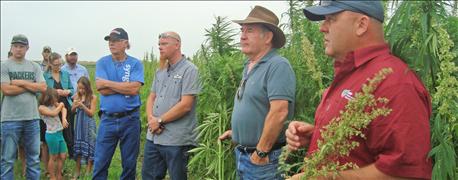August 26, 2016

Industrial hemp is being grown in North Dakota under a pilot program supervised by the North Dakota Department of Agriculture. Seven things to know about the program and industrial hemp, in general, are:
* Industrial hemp and marijuana are different. The level of delta-9 tetrahydrocannabinol (THC), marijuana’s primary psychoactive chemical, in industrial hemp plants is generally less than 1%. THC levels in marijuana plants average about 10%. Some sample tests indicate THC levels reaching 20%-30%, or greater.

HEMP TOUR: Growers get a look at a good industrial hemp crop during a tour near Adrian, N.D. Photo: NDDA
* Five farmers were accepted into the NDDA industrial hemp pilot program. They are Jamie Edwards, Adrian; Lyle Edwards, Adrian; David Lommen, Maddock; Clarence Laub, Elgin; and Roger Gussiaas, Carrington. North Dakota State University has been conducting industrial hemp research for two years. The goal of the pilot program is to increase knowledge of how industrial hemp fits into the existing agricultural landscape and economy. NDSU researchers and farmers are focusing their research on variety trials, grain processing and grain marketing. They will harvest the hemp grain, it will be devitalized, and then the producers will be able to sell it.
* Yield information from 2016 is not available yet, but hemp seems to have grown well in most parts of the state except the northeast. “It has been a difficult year [for hemp],” says Bryan Hanson, NDSU research agronomist at the Langdon station. “Since May 1, we have had about 18 inches of rain with most of that coming after May 22. Hemp is very sensitive to waterlogged soils, so in all likelihood we will not have any harvest data this year.”
* It’s estimated that there are 25,000 different products being made out of industrial hemp including food, beverages, cosmetics, yarns, papers and construction materials.
* The size of the U.S. market is estimated at $580 million annually. Most products are currently imported from China and Canada. More than 30 nations grow industrial hemp.
* According to a USDA study, U.S. hemp markets “are, and will likely remain, small, thin markets.” The study cited the “uncertainty of long-run demand and the potential for oversupply” among possible downsides of potential future hemp production. A University of Wisconsin-Madison study concluded that hemp production “is not likely to generate sizable profits” and although hemp may be “slightly more profitable than traditional row crops,” it is likely “less profitable than other specialty crops” due to the “current state of harvesting and processing technologies, which are quite labor-intensive, and result in relatively high per-unit costs.” The study warns that U.S. hemp growers could be affected by competition from other world producers as well as by certain production limitations in the United States. Those include yield variability and lack of harvesting innovations and processing facilities in the U.S., as well as difficulty transporting bulk hemp. The study further claims that most estimates of profitability from hemp production are highly speculative and often do not include additional costs of growing hemp in a regulated market, such as the cost associated with “licensing, monitoring and verification of commercial hemp.”
* NDDA might do the industrial hemp pilot program again in 2017. It depends on the department’s budget, which has been cut due to the downturn in oil production.
Sources: Rachel Seifert-Spilde, NDDA plant protection specialist; Bryan Hanson, North Dakota State University Langdon Research Extension Center; “Hemp as an Agricultural Commodity,” Federation of American Scientists, February 2015.
You May Also Like




